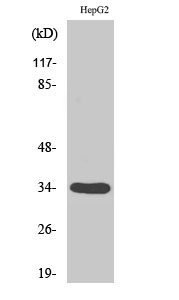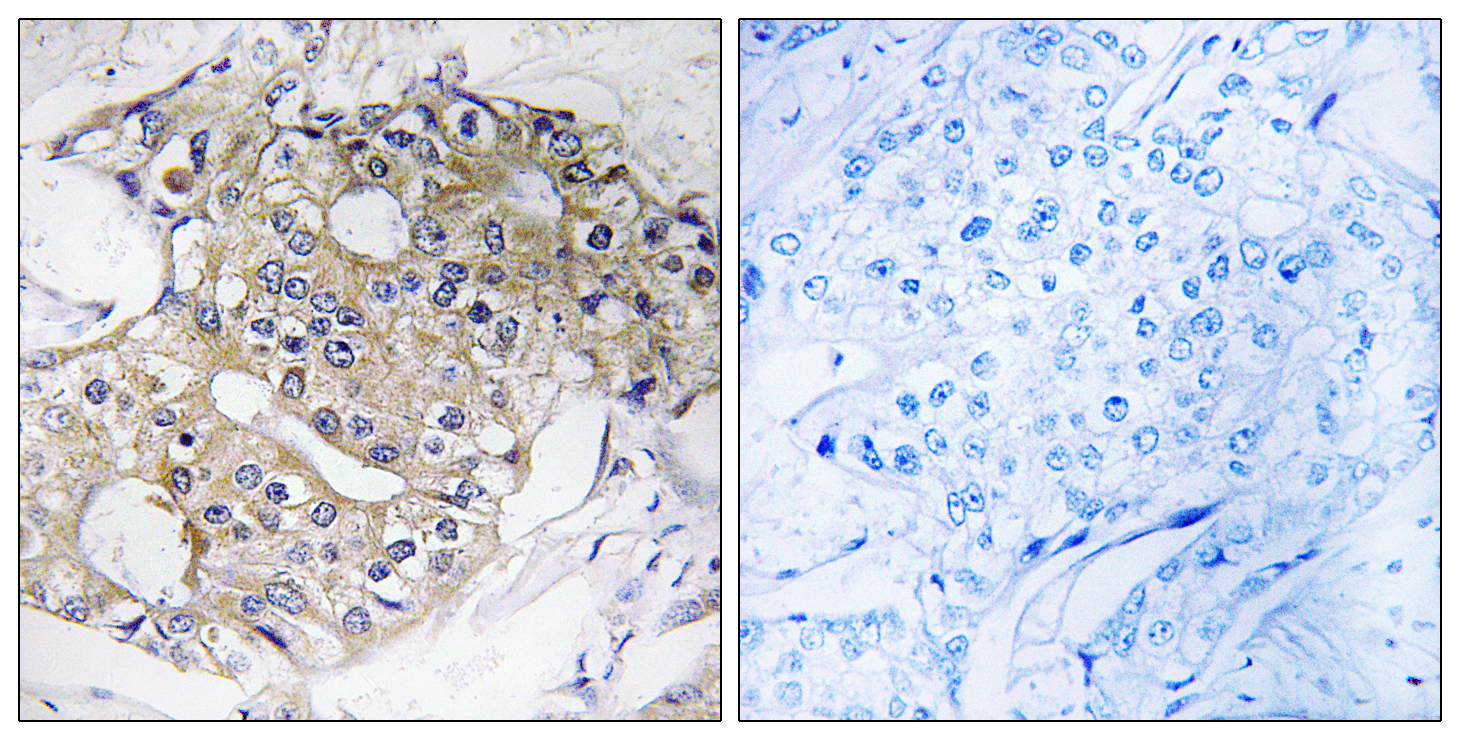DHRS4 Polyclonal Antibody
- Catalog No.:YT1349
- Applications:WB;IHC;IF;ELISA
- Reactivity:Human;Rat;Mouse;
- Target:
- DHRS4
- Fields:
- >>Retinol metabolism;>>Metabolic pathways;>>Peroxisome
- Gene Name:
- DHRS4
- Protein Name:
- Dehydrogenase/reductase SDR family member 4
- Human Gene Id:
- 10901
- Human Swiss Prot No:
- Q9BTZ2
- Mouse Swiss Prot No:
- Q99LB2
- Immunogen:
- The antiserum was produced against synthesized peptide derived from human DHRS4. AA range:191-240
- Specificity:
- DHRS4 Polyclonal Antibody detects endogenous levels of DHRS4 protein.
- Formulation:
- Liquid in PBS containing 50% glycerol, 0.5% BSA and 0.02% sodium azide.
- Source:
- Polyclonal, Rabbit,IgG
- Dilution:
- WB 1:500 - 1:2000. IHC 1:100 - 1:300. ELISA: 1:40000.. IF 1:50-200
- Purification:
- The antibody was affinity-purified from rabbit antiserum by affinity-chromatography using epitope-specific immunogen.
- Concentration:
- 1 mg/ml
- Storage Stability:
- -15°C to -25°C/1 year(Do not lower than -25°C)
- Other Name:
- DHRS4;Dehydrogenase/reductase SDR family member 4;NADPH-dependent carbonyl reductase/NADP-retinol dehydrogenase;CR;PHCR;NADPH-dependent retinol dehydrogenase/reductase;NRDR;humNRDR;Peroxisomal short-chain alcohol dehydrogenase;PSCD
- Observed Band(KD):
- 32-34kD
- Background:
- catalytic activity:R-CHOH-R' + NADP(+) = R-CO-R' + NADPH.,function:Reduces all-trans-retinal and 9-cis retinal. Can also catalyze the oxidation of all-trans-retinol with NADP as co-factor, but with much lower efficiency. Reduces alkyl phenyl ketones and alpha-dicarbonyl compounds with aromatic rings, such as pyrimidine-4-aldehyde, 3-benzoylpyridine, 4-benzoylpyridine, menadione and 4-hexanoylpyridine. Has no activity towards aliphatic aldehydes and ketones.,miscellaneous:Inhibited by kaempferol, quercetin, genistein and myristic acid.,similarity:Belongs to the short-chain dehydrogenases/reductases (SDR) family.,subcellular location:Isoform 1 is peroxisomal, while isoform 4 is not.,subunit:Homotetramer.,tissue specificity:Isoform 1 is predominantly expressed in normal cervix (at protein level). Isoform 4 is expressed in some neoplastic cervical tissues, but not in normal cervix (at protein level). Isoforms 5 and 6 are expressed in a few neoplastic cervical tissues.,
- Function:
- catalytic activity:R-CHOH-R' + NADP(+) = R-CO-R' + NADPH.,function:Reduces all-trans-retinal and 9-cis retinal. Can also catalyze the oxidation of all-trans-retinol with NADP as co-factor, but with much lower efficiency. Reduces alkyl phenyl ketones and alpha-dicarbonyl compounds with aromatic rings, such as pyrimidine-4-aldehyde, 3-benzoylpyridine, 4-benzoylpyridine, menadione and 4-hexanoylpyridine. Has no activity towards aliphatic aldehydes and ketones.,miscellaneous:Inhibited by kaempferol, quercetin, genistein and myristic acid.,similarity:Belongs to the short-chain dehydrogenases/reductases (SDR) family.,subcellular location:Isoform 1 is peroxisomal, while isoform 4 is not.,subunit:Homotetramer.,tissue specificity:Isoform 1 is predominantly expressed in normal cervix (at protein level). Isoform 4 is expressed in some neoplastic cervical tissues, but not in normal cervix (at protei
- Subcellular Location:
- [Isoform 1]: Peroxisome . Isoform 4 is not peroxisomal. .; [Isoform 7]: Nucleus .
- Expression:
- [Isoform 1]: Predominantly expressed in normal cervix (at protein level). ; [Isoform 4]: Expressed in some neoplastic cervical tissues, but not in normal cervix (at protein level). ; [Isoform 5]: Expressed in a few neoplastic cervical tissues. ; [Isoform 6]: Expressed in a few neoplastic cervical tissues. ; [Isoform 8]: High expression in liver.
- June 19-2018
- WESTERN IMMUNOBLOTTING PROTOCOL
- June 19-2018
- IMMUNOHISTOCHEMISTRY-PARAFFIN PROTOCOL
- June 19-2018
- IMMUNOFLUORESCENCE PROTOCOL
- September 08-2020
- FLOW-CYTOMEYRT-PROTOCOL
- May 20-2022
- Cell-Based ELISA│解您多样本WB检测之困扰
- July 13-2018
- CELL-BASED-ELISA-PROTOCOL-FOR-ACETYL-PROTEIN
- July 13-2018
- CELL-BASED-ELISA-PROTOCOL-FOR-PHOSPHO-PROTEIN
- July 13-2018
- Antibody-FAQs
- Products Images

- Western Blot analysis of various cells using DHRS4 Polyclonal Antibody diluted at 1:2000

- Immunohistochemistry analysis of paraffin-embedded human breast carcinoma tissue, using DHRS4 Antibody. The picture on the right is blocked with the synthesized peptide.

- Western blot analysis of lysates from HepG2 cells, using DHRS4 Antibody. The lane on the right is blocked with the synthesized peptide.



